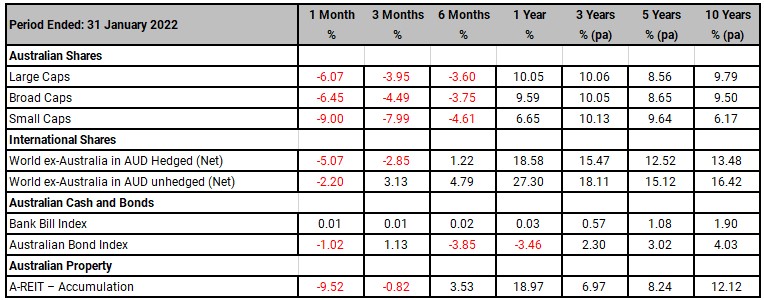Research Insights – Market Commentary January 2022
In January equity markets reacted to further COVID related supply chain issues, higher inflation prints, rising bond yields, political tensions between Russia and Ukraine, and increasingly likely central bank cash rate hikes. Many equity indices fell more than 10% intra-month before market participants “bought the dip” late in January, stemming losses. These share market movements provided a rude awakening for complacent investors who now realise markets in fact do go down as well as up.
In an attempt to reduce the potential of run-away inflation, central bank rhetoric has once again shifted, with quantitative easing programs being shuttered, cash rate hikes being brought forward and the magnitude of such rate hikes increasing. For example, some forecasters now expect the US Federal Reserve to raise rates up to seven times in 2022, with an end-year cash rate of 2.75% to 3%. Australian investors forecast the RBA rate to reach 1.0% by December 2022, following the most recent inflation print of +1.3% for the December 2021 quarter and +3.5% for calendar 2021, well above the target band of 2-3%.
One factor that will continue to impact on market sentiment is the resolution (militarily or otherwise) of Russian / Ukraine tensions. Russia has used its energy pipelines to Europe as leverage, with the result that energy prices (a key component of core inflation) increased around 40% in the month of January.
Australian equities were down 6.5% in January, small caps fell further than larger companies in the month. Currency hedged International equities fell 5.1% whilst a falling Australian dollar, down 2.8% buying US$0.7062, moderated losses for unhedged investors – the MSCI ex-Australia unhedged index delivered -2.2%. Passive bond holders lost 1.0% in the month, while listed Australian Property reacted to rising bond yields falling by 9.5%.
Australian government bond yields moved higher in January with the 10-year government bond yield increasing by 23bps to 1.90% and the 2-year government bond rising 29bps to 0.88%. US yields rose, with the 10-year government bond yield gaining 27bps to close at 1.78% and the 2-year government bond yield increasing by 45bps to 1.18%. Notably, the German 10-year government bond yield closed January above zero percent after spending nearly three years in negative territory.
Benchmark Returns
Important information
RESEARCH INSIGHTS IS A PUBLICATION OF AUSTRALIAN UNITY PERSONAL FINANCIAL SERVICES LIMITED ABN 26 098 725 145 (AUPFS). ANY ADVICE IN THIS ARTICLE IS GENERAL ADVICE ONLY AND DOES NOT TAKE INTO ACCOUNT THE OBJECTIVES, FINANCIAL SITUATION OR NEEDS OF ANY PARTICULAR PERSON. IT DOES NOT REPRESENT LEGAL, TAX OR PERSONAL ADVICE AND SHOULD NOT BE RELIED ON AS SUCH. YOU SHOULD OBTAIN FINANCIAL ADVICE RELEVANT TO YOUR CIRCUMSTANCES BEFORE MAKING PRODUCT DECISIONS. WHERE APPROPRIATE, SEEK PROFESSIONAL ADVICE FROM A FINANCIAL ADVISER. WHERE A PARTICULAR FINANCIAL PRODUCT IS MENTIONED, YOU SHOULD CONSIDER THE PRODUCT DISCLOSURE STATEMENT BEFORE MAKING ANY DECISIONS IN RELATION TO THE PRODUCT AND WE MAKE NO GUARANTEES REGARDING FUTURE PERFORMANCE OR IN RELATION TO ANY PARTICULAR OUTCOME. WHILST EVERY CARE HAS BEEN TAKEN IN THE PREPARATION OF THIS INFORMATION, IT MAY NOT REMAIN CURRENT AFTER THE DATE OF PUBLICATION AND AUSTRALIAN UNITY PERSONAL FINANCIAL SERVICES LTD (AUPFS) AND ITS RELATED BODIES CORPORATE MAKE NO REPRESENTATION AS TO ITS ACCURACY OR COMPLETENESS.
